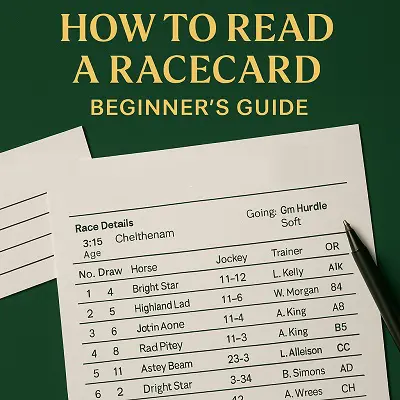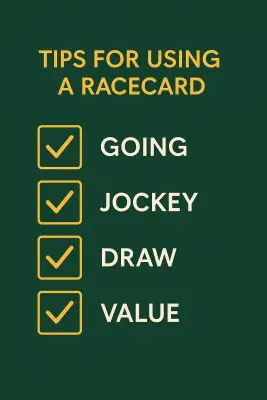When it comes to horse racing betting, the racecard is a gamblers best friend. Think of it as the matchday programme, stats sheet, and form guide all rolled into one. It’s packed with the key details you need before putting your money down.
Whether you’re standing trackside at Cheltenham, scrolling through your bookmaker’s app, or flicking through the racing pages in the morning paper, the racecard tells you who’s running, what the conditions are, and how each horse has been performing.
This guide will walk you through exactly how to read a racecard. From race types and form figures, to spotting those handy little abbreviations like CD (course & distance winner) that experienced punters swear by. By the end, you’ll know how to look beyond the favourite and start picking out real value bets.
What is a Racecard?
 A racecard is the official guide to a horse race, giving punters all the key details they need before placing a bet. Think of it as a compact info sheet that tells you exactly what race is being run, which horses are taking part, who’s riding them, and how they’ve performed recently.
A racecard is the official guide to a horse race, giving punters all the key details they need before placing a bet. Think of it as a compact info sheet that tells you exactly what race is being run, which horses are taking part, who’s riding them, and how they’ve performed recently.
You’ll find racecards available in several places:
- Bookmaker websites and apps – usually interactive, letting you click through for deeper stats, form guides, and even video replays.
- Newspapers – the traditional home of racing cards, often showing the essentials like runners, riders, weights, and form figures.
- Racecourses – on the day, you can pick up a printed card or programme that gives you a breakdown of every race on the card.
For horse racing fans, the racecard is more than just a list of names. It’s a decision-making tool. By reading it properly, you can judge how conditions might suit certain horses, whether a jockey has a strong strike rate at the track, or if a horse has the right form to go well.
Key Information on a Racecard
Learning how to read a racecard is one of the most valuable skills you can develop if you want to bet smarter on horse racing. So what exactly is the information you can find on the average racecard?
- Race Details
At the top of every racecard, you’ll see the essential details about the race itself. Before you even look at the horses, this information helps you understand the challenge each runner is about to face.
- Race Time & Course – Each race is listed by its off-time and track. For example, 3:15 Cheltenham tells you exactly when and where the action takes place. On busy festival days, this helps punters keep track of multiple races across different meetings.
- Distance – Horse races vary from sharp 5-furlong sprints to marathon 3-mile chases. Some horses are natural speedsters, while others excel over stamina-testing distances. The distance listed on the card shows you what type of test it is.
- Going (Ground Conditions) – The “going” describes how firm or soft the turf is, from firm through to heavy. Certain horses act best on quick ground, while others relish a mud bath. A horse’s past form on similar going is one of the most important factors punters look at.
- Type of Race – Every race fits into a category, such as:
- Flat – Run on level ground with no obstacles.
- Hurdle – Jumps races with smaller, flexible obstacles.
- Chase (Steeplechase) – Bigger fences that require more jumping ability.
- Handicap – Horses carry different weights based on ability, aiming to level the playing field.
- Maiden – Restricted to horses that haven’t won a race before.
Understanding these details gives context to everything else on the racecard. For example, a horse stepping up in distance, or one that’s proven in soft going when the track is heavy, could be a real pointer to value.
- Horse Information
Once you’ve clocked the race details, your eyes will naturally move to the list of runners. This is where the racecard really comes alive, giving you the lowdown on each horse in the field. Here’s what you’ll find:
- Horse’s Name & Number – Every runner is listed with a number for easy reference, plus its name. You’ll also see the owner’s colours (silks) further down the card so you can spot your horse on the track.
- Age – Horses peak at different stages, and age can matter. A 3-year-old might struggle against older, stronger rivals in an open handicap, while seasoned jumpers often improve with maturity.
- Weight – This is the burden the horse carries, shown in stones and pounds (e.g., 11-4 means 11 stone 4 pounds). In handicaps, weight is crucial, as the aim is to balance the race by giving better horses more to carry.
- Official Rating (OR) – Given by the handicapper, this number is a quick measure of a horse’s ability. The higher the OR, the better the horse is judged to be. Ratings are especially useful when comparing horses in handicaps.
- Form Figures – These little strings of numbers tell you how the horse has finished in its recent races. For example, 4213 means the horse was 4th, 2nd, 1st, then 3rd in its last four starts. Letters can also appear here (explained in more detail later).
- Draw (Stall Position) – In flat racing, each horse is assigned a stall number. The “draw” can be a big factor at certain tracks where low or high numbers are favoured. Savvy punters always check the draw bias before betting.
This section is where punters start piecing together the puzzle. A lightly weighted horse with strong form figures, or one drawn favourably on a sprint track, might jump out as a strong contender.
- Jockey & Trainer
Behind every horse, there’s a team – and the jockey and trainer are two of the most influential factors shown on a racecard. Knowing how to interpret their names can give punters a real edge.
- The Jockey – Listed alongside each runner, the jockey is the rider in the saddle. Top-class jockeys are worth their weight in gold; their race-riding skills, timing, and experience can make the difference between winning and losing. Some jockeys also have a proven record at certain courses – for example, being particularly strong at tricky, undulating tracks like Cheltenham. Punters often look for jockeys who are “in form” (riding plenty of recent winners) as a sign of confidence.
- The Trainer – The trainer’s name will also appear on the racecard, and it’s just as important. Certain trainers specialise in preparing horses for specific meetings, while others have high strike rates at particular tracks. A trainer on a hot streak can be a major betting angle, especially if they’re running multiple horses in one day.
- Jockey/Trainer Partnerships – Some combinations of jockey and trainer are especially profitable. When you spot a top jockey booked for a leading trainer, it’s often a strong signal of intent. Seasoned punters keep tabs on these partnerships to see which ones regularly deliver winners.
In short, the jockey and trainer line isn’t just a namecheck – it’s a valuable indicator of a horse’s chances, preparation, and connections. Often, spotting the right trainer in form or a clever jockey booking can lead you to a bet that most casual punters overlook.
- Recent Form & Symbols Explained
The form figures on a racecard are one of the first things punters check. They give a quick snapshot of how each horse has performed in its recent runs, but to read them properly you need to understand the numbers and abbreviations used.
- Numbers (1–9) – A simple system:
- 1 = the horse won.
- 2 = finished second, and so on.
- If you see 0, it means the horse finished outside the top nine.
- Two-Digit Finishes (10, 11, etc.) – In bigger fields, you may see two-digit numbers. For example, 10 means the horse finished 10th.
Key Letters You’ll See
- P = Pulled Up (the jockey stopped riding before the finish).
- F = Fell.
- UR = Unseated Rider.
- BD = Brought Down (knocked over by another horse).
- R = Refused to start or jump.
Bonus Symbols
Racecards also highlight past achievements with helpful markers:
- C = Course winner (has won at this track before).
- D = Distance winner (has won over this distance).
- CD = Course & Distance winner (the perfect combo for punters looking for proven ability).
- BF = Beaten Favourite (the horse started favourite last time but lost).
Why It Matters
These figures help punters judge current form, reliability, and suitability. For example:
- A horse with recent 1s and 2s is clearly in good nick.
- A CD winner running under similar conditions is always worth a second look.
- If you see a string of 0s and Ps, the horse may be out of form, but don’t dismiss it entirely; sometimes these can bounce back at big prices.
Learning to read form figures and symbols turns a confusing line of numbers into actionable betting clues.
- Odds & SP (Starting Price)
Every racecard lists the odds for each runner, showing punters how the market rates their chances. Understanding what those numbers mean, and how they can change, is crucial before placing a bet.
- Fractional Odds (UK style) – The most common format on racecards in Britain. For example:
- 5/1 means you win £5 for every £1 staked (plus your stake back).
- 2/1 means £2 profit for every £1 bet.
- The smaller the fraction (like Evens or 6/4), the shorter the price, meaning the horse is more fancied.
- Early Prices – Many online bookmakers, such as bet365, show early odds before race day. These can be tempting if you fancy a horse, as they often change once money starts coming in. Punters who spot value early can lock in a better price, especially if best odds guaranteed promos are available.
- SP (Starting Price) – This is the official price of the horse at the start of the race. If you take SP on your bet, you’ll be paid out at whatever the odds are when the race goes off. It’s the traditional option, especially at the track.
- Tote Odds – On-course pool betting (the Tote) works differently. Instead of fixed odds, payouts depend on how much money is in the pool for each horse. Sometimes Tote dividends beat SP, especially in big-field handicaps.
Why It Matters
Smart punters look beyond just the odds of the favourite. By comparing early prices, SP, and Tote returns, you can often find better value, especially if the horse you fancy has been drifting or overlooked by the market.
- Colours & Silks
One of the most eye-catching parts of a racecard is the set of jockey silks, the colours and patterns worn by each rider. These are tied to the horse’s owner and act like a unique uniform, helping spectators quickly spot their horse during the race.
- Why They Matter – With a dozen or more runners thundering down the track, silks make it easy to follow your selection. For example, if your racecard shows “Blue with white stars,” you’ll know exactly what to look out for once the stalls open.
- Consistent to the Owner – The silks belong to the owner, not the jockey. That means the same colours can appear across different races if the owner has multiple horses running on the card.
- Illustrated on Racecards – Most modern bookmaker apps and online racecards now display a little graphic of the silks alongside each horse’s name and number. In print versions, they’re often shown as descriptions (e.g., “Maroon with yellow cap”).
- Special Cases – Occasionally, jockeys may wear a substitute set of silks if there’s a clash or technical issue, but this is rare and usually announced before the race.
Betting Angle
While silks don’t directly affect a horse’s chances, they’re a vital identification tool. Punters who follow racing closely often get to know certain famous silks, like the royal blue of Godolphin, or the green and gold hoops of JP McManus, and these can be an early clue to a horse’s backing and pedigree.
Tips for Using a Racecard Effectively
 Knowing what the information means is one thing, but learning how to put it all together is where punters can really find value. Here are some tried-and-tested ways to use a racecard like a pro:
Knowing what the information means is one thing, but learning how to put it all together is where punters can really find value. Here are some tried-and-tested ways to use a racecard like a pro:
- Look for the right conditions – Check if a horse has won over the course and distance (CD) or on similar going (ground conditions). A proven track record under today’s conditions is often a big positive.
- Balance form with context – Good form figures (like 1123) catch the eye, but always consider the class of race they came in. A horse winning at a lower level may struggle when stepping up in grade.
- Trainer & jockey signals – Spotting a trainer in hot form or a strong jockey can be the clue that today is the day a horse is primed to run big.
- Weight & ratings matter – In handicaps especially, look at the weight carried and the official rating (OR). A horse dropping down the weights can be a live outsider.
- Don’t just follow favourites – Racecards give you the detail to dig deeper. Plenty of value can be found in second or third favourites, or even outsiders with strong CD records.
Common Traps Beginners Fall Into
- Backing a horse just because it won last time out — context is everything.
- Ignoring the going — soft or heavy ground can transform the form book.
- Forgetting about the draw in sprints — a bad stall position can ruin chances before the gates even open.
Pro Tip
Use racecards alongside live stats, expert previews, and replays. A racecard gives you the raw data, but combining it with real-time insights helps you make sharper, more confident bets.
Example Racecard Walkthrough
Sometimes the easiest way to understand a racecard is to see one broken down piece by piece. Below is a sample racecard snapshot with each section explained.
- Race Details – 2:30 Ascot – 7f Handicap, Going: Good to Soft
- Tells you when the race is, where it’s being run, the distance, the race type, and the ground conditions.
- Horse Number & Name – No. 4 – “Star Chaser”
- The number helps you track the horse in the betting markets and on-course commentary.
- Age / Weight / OR – 4yo, 9-2 (OR 88)
- This horse is four years old, carrying 9 stone 2 pounds, and has an official handicap rating of 88.
- Form Figures – 21-34
- A second, a win, unplaced (0–9 shown as dashes), then 3rd and 4th in its most recent runs. Shows this horse has been consistently competitive.
- Jockey & Trainer – J: W. Buick / T: C. Appleby
- A top jockey and trainer combo, which could be a strong betting angle.
- Draw (Flat Racing) – Drawn in stall 2
- A low draw, which at Ascot over 7f may be an advantage depending on track bias.
- Odds – 5/1 (Early Price), SP pending
- Shows what price you can currently get and flags that SP will be confirmed at the off.
- Silks – Royal blue with white cap
- The owner’s colours, letting you spot the horse in-running.
Why This Helps Punters
By breaking down a racecard line by line, you see how the details fit together. Instead of just scanning the odds, you can spot things like:
- A proven CD winner on similar going.
- A trainer in form with a top jockey booking.
- A horse carrying less weight than rivals despite strong recent form.
This kind of joined-up reading is what separates casual bettors from value-seeking punters.
Summary of Racecards
For punters, the racecard is more than just a list of runners, it’s a roadmap to making smarter betting decisions. By learning how to read the details on course, distance, going, weights, form, and trainer/jockey stats, you give yourself a real edge over casual gamblers who only look at the favourite’s odds.
Whether you’re betting online, flicking through the racing pages, or following the action live at the course, a racecard helps you piece together the story of the race before the stalls even open.
FAQs about Racecards
❓ How many past races are shown in the form?
Most racecards display the horse’s last 5 or 6 runs, but this can vary. Online racecards often give you the option to view a much deeper history, along with filters for going, distance, or track. In newspapers and printed cards, space is limited, so you’ll usually only see the most recent handful of runs.
❓ What is a good official rating (OR)?
That depends on the race type. In handicaps, higher-rated horses carry more weight. A top Flat handicapper might be rated 100+, while a strong National Hunt chaser could be rated 150+. The key is comparing a horse’s OR to its rivals in the same race, a horse dropping a few pounds in the ratings can suddenly become very competitive.
❓ Are online racecards better than print ones?
Online racecards are often more detailed, interactive, and up-to-date. Many bookmaker apps include extras like video replays, trainer/jockey strike rates, and live odds updates. Printed racecards, whether from newspapers or sold at the track, are still handy for a quick overview — especially if you like scribbling notes in the margins — but for serious punting, digital versions usually offer more depth.
❓ Why do some racecards show abbreviations like BF or UR?
These are shorthand for race outcomes. BF means the horse was a Beaten Favourite last time out, while UR means the horse Unseated its Rider. There are several of these abbreviations, and understanding them can help you judge reliability and context.





